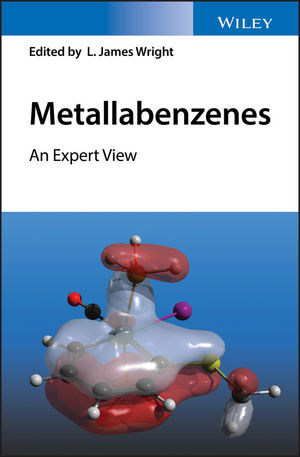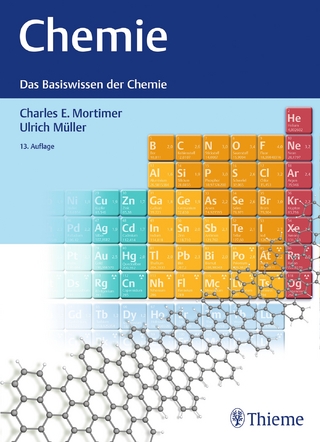
Metallabenzenes
John Wiley & Sons Inc (Verlag)
978-1-119-06806-8 (ISBN)
The only comprehensive book covering of advances in metallabenzene chemistry—written by the leading experts in the field
Metallabenzenes: An Expert View provides comprehensive coverage of all aspects of metallabenzene chemistry, including syntheses, reactions, physical properties, and theoretical treatments of metallabenzenes. Fused ring metallabenzenes, heterometallabenzenes, and metallabenzenes that are p-bound to other metal fragments are also discussed in depth.
Although benzene itself was discovered in 1825, it wasn’t until 1982 that the first metallabenzene was isolated. Since then, interest in these compounds has built steadily, and metallabenzene chemistry is now a flourishing sub discipline in its own right. A diverse range of synthetic approaches to these compounds have been devised, and new developments and discoveries have appeared regularly over the past several decades. Yet, until now, no books devoted to this fascinating and important class of chemical compounds have been available to researchers and students. This bookfills that gap in the literature with a comprehensive review of recent advances in metallabenzene chemistry theory and applications. Featuring contributions by an international group of experts in the field, each chapter summarizes important recent research in and significant contributions to various aspects of metallabenzene chemistry.
Provides academics, researchers and graduate students with a comprehensive review of advances in metallabenzene research
Covers fused-ring metallabenzenes—including metallanaphthalenes, metallabenzofurans, and metallabenzothiophenes—as well as p-bound heterometallabenzenes and metallabenzenes
Reviews the latest computational studies that have led to the theoretical understanding of metallabenzenes
Includes critical discussions of metallabenzene aromaticity, an area rarely covered by computational experts
Metallabenzenes: An Expert View is an important working resource for those working in organometallic chemistry, aromaticity, coordination chemistry, theoretical chemistry, catalysis and materials science. It is also an excellent text for graduate-level courses in those areas.
L. James Wright is a Professor in the School of Chemical Sciences, University of Auckland, New Zealand. Professor Wright has been an active researcher in the area of metallabenzenes for over 15 years and has published reviews and articles on various aspects of metallabenzene chemistry. His current research focuses on organometallic chemistry, including metallabenzenes and new carbon donor ligands, carbon donor ligands, development of new nitrogen donor ligands, macrocyclic complexes, CORMs, catalysis, oxidation chemistry and green chemistry.
List of Contributors xi
Preface xiii
1 Metallabenzenes and Fused-Ring Metallabenzenes of Osmium, Ruthenium and Iridium: Syntheses, Properties and Reactions 1
Benjamin J. Frogley, Warren R. Roper and L. James Wright
1.1 Introduction 1
1.2 Syntheses and Properties of Metallabenzenes with Methylthiolate Substituents 2
1.2.1 Osmabenzenes 2
1.2.2 Iridabenzenes 7
1.3 Syntheses and Properties of Fused-Ring Metallabenzenes 10
1.3.1 Osmabenzofurans 11
1.3.2 Ruthenabenzofurans 14
1.3.3 Iridabenzofurans 17
1.3.4 Iridabenzothiophenes 19
1.3.5 Iridabenzothiazolium Cations 21
1.4 Reactions of Metallabenzenes and Metallabenzenoids 24
1.4.1 Electrophilic Aromatic Substitution Reactions 24
1.4.2 Rearrangement to Cyclopentadienyl Complexes 34
1.4.3 Nucleophilic Aromatic Substitution Reactions 38
1.5 Concluding Remarks 43
References 43
2 The First Iridabenzenes: Syntheses, Properties, and Reactions 51
John R. Bleeke
2.1 Introduction 51
2.2 Basic Theory 52
2.3 Discovery of the First Stable Metallabenzenes 54
2.4 Synthesis of Iridabenzene 54
2.5 Valence Bond Structures and Electron Counting for Iridabenzene 56
2.6 The Tris(trimethylphosphine) Reaction System 57
2.7 Structure and Spectroscopy of Iridabenzene 3 58
2.8 Chemical Reactivity of Iridabenzene 3 60
2.8.1 Ligand Substitution 60
2.8.2 Oxidative Addition/Oxidation 63
2.8.3 Cycloaddition 65
2.8.4 Theoretical Study of Cycloaddition 68
2.8.5 Electrophilic Addition 69
2.8.6 Coordination to Mo(CO)3 71
2.9 Iridaphenol 73
2.10 Synthesis and Spectroscopy of Iridapyrylium 78
2.11 Valence Bond Structures and Electron Counting for Iridapyrylium 80
2.12 Chemical Reactivity of Iridapyrylium 37 80
2.12.1 Ligand Addition 80
2.12.2 Cycloaddition 81
2.13 Comparison of Iridabenzene 3 and Iridapyrylium 37 83
2.14 Synthesis and Spectroscopy of Iridathiabenzene 83
2.15 Structure of Iridathiabenzene 50 85
2.16 Chemical Reactivity of Iridathiabenzene 50 86
2.16.1 Ligand Addition and Cycloaddition 86
2.16.2 Coordination to Other Metals 86
2.17 Comparison of Iridathiabenzene 50 and Iridapyrylium 37 89
2.18 Synthesis and Structure of a Neutral Iridathiabenzene 89
2.19 Spectroscopy of Neutral Iridathiabenzene 56 90
2.20 Chemical Reactivity of Neutral Iridathiabenzene 56 91
2.21 Related Metal-Coordinated Metallabenzenes 94
2.22 Aromaticity 99
2.22.1 Electronic Structure 99
2.22.2 Structural (Geometric) Features 99
2.22.3 Magnetic Properties 100
2.22.4 Stability 100
2.22.5 Chemical Reactivity 101
2.22.6 Conclusion 101
2.23 Final Word 102
References
102
3 Metallabenzenes and Valence Isomers via the Nucleophilic 3-Vinylcyclopropene Route 109
Michael M. Haley
3.1 Project Origin and Inspiration (A Nod to Binger, Bleeke, Grubbs, Hughes, and Roper) 109
3.2 Ligand Synthesis (An Exercise in Over-Engineering) 111
3.3 Iridabenzenes and Valence Isomers (Success after Six Long Years) 114
3.3.1 Iridabenzene/Iridabenzvalene Synthesis 114
3.3.2 Mechanisms of Iridabenzvalene Isomerization and Iridabenzene Rearrangement 120
3.3.3 Iridabenzene/Iridabenzvalene Spectroscopic Properties 123
3.3.4 Iridabenzene/Iridabenzvalene Solid]State Structures 125
3.4 Platinabenzenes (How You Get Your Chemistry on a Beer Coaster) 126
3.4.1 “Irrational” Platinabenzene Synthesis 126
3.4.2 “Rational” Platinabenzene Synthesis 129
3.4.3 Platinabenzene Spectroscopic Properties and Solid]State Structures 130
3.5 Odds and Sods (Ones that Got Away) 132
3.5.1 16]Electron, High Oxidation State Iridabenzenes 133
3.5.2 Hammett Plot of Iridabenzvalene Isomerization 135
3.5.3 Rhodabenzvalene and Putative Dewar Rhodabenzene 137
3.6 Conclusion (So Long, and Thanks for All the Fish) 139
3.7 Acknowledgements 140
References 140
4 Iridabenzenes and Iridanaphthalenes with Supporting Tris(pyrazolyl)borate Ligands 145
Margarita Paneque and Nuria Rendón
4.1 Introduction 145
4.2 Synthetic Routes to Iridaaromatic Derivatives with Supporting Tris(pyrazolyl)borate Ligands 146
4.2.1 Oxidatively Induced Ring Contraction 146
4.2.2 Synthesis of Iridaaromatics by Ring Expansion Reactions 148
4.2.2.1 Protonation of a Vinylidene]Iridacyclopentene 149
4.2.2.2 Preparation of TpMe2]Iridaaromatics by Reaction of Olefins with Iridacyclopentadienes 153
4.2.2.2.1 Iridabenzenes 153
4.2.2.2.2 Iridanaphthalenes 157
4.2.2.3 Other Procedures for Ring Expansion Reactions 161
4.2.2.3.1 Reaction of a TpMe2-Iridaindene with Bis(trimethylsilyl)acetylene 161
4.2.2.3.2 Coupling of Two Molecules of Acetylene and a Further C1 Fragment in a TpIr Precursor 164
4.3 Reactivity of Iridaaromatics with Supporting Tris(pyrazolyl)borate ligands 166
4.4 Structural Data for Iridaaromatics with Supporting Tris(pyrazolyl)borate Ligands 171
4.5 Spectroscopic Data for Iridaaromatics with Supporting Tris(Pyrazolyl)Borate Ligands 175
4.6 Conclusions 177
References 178
5 Chemistry of Metallabenzynes and Rhenabenzenes 185
Guochen Jia
5.1 Introduction 185
5.2 Chemistry of Metallabenzynes 186
5.2.1 Routes to Construct Metallabenzyne Rings 186
5.2.1.1 Reactions of Terminal Alkynes with OsCl2(PPh3)3 186
5.2.1.2 Reactions of Allenylcarbene and Vinylidene Complexes with Acetylides or Alkynes 186
5.2.1.3 Oxidative Addition Reactions of Vinyl Carbyne Complexes 188
5.2.1.4 Isomerization of Alkyne]Carbene Complexes 189
5.2.2 Chemical Properties of Metallabenzynes 189
5.2.2.1 Reactions Not Involving Carbons of the Metallabenzyne Ring 189
5.2.2.2 Electrophilic Substitution Reactions 191
5.2.2.3 Nucleophilic Addition Reactions 193
5.2.2.4 Migratory Insertion Reactions 193
5.2.3 Structural Properties of Metallabenzynes 202
5.2.4 Ring Strain of Metallabenzynes 203
5.2.5 Electronic Structures of Metallabenzynes 204
5.2.5.1 Aromatic Properties of Metallabenzynes 205
5.3 Chemistry of Rhenabenzenes 207
5.3.1 Synthesis of Rhenabenzenes 207
5.3.2 Structural and Aromatic Properties of Rhenabenzenes 208
5.3.3 Rearrangement of Low]valent Rhenabenzene to η5]Cyclopentadienyl Complexes 209
5.4 Summary 215
References 216
6 Metallabenzenoid Compounds Bearing Phosphonium Substituents 219
Hong Zhang and Haiping Xia
6.1 Synthesis 220
6.1.1 [5+1] Synthesis 220
6.1.1.1 Syntheses Starting from HC≡CCH(OH)C≡CH 220
6.1.1.2 Syntheses Starting from HC≡CCH(OH)CH=CH2 and HC≡CCCH3(OH)CH=CH2 223
6.1.1.3 Syntheses Starting from HC≡CCH(OH)Ph 223
6.1.1.4 Synthesis Starting from HC≡CCH(OH)Et 225
6.1.2 [4+2] Synthesis 226
6.1.3 [3+3] Synthesis 228
6.2 Structure and Bonding 229
6.3 Reactions 232
6.3.1 Ligand Substitution Reactions 232
6.3.2 Nucleophilic Addition and Nucleophilic Aromatic Substitution Reactions 233
6.3.3 Cycloaddition Reactions 239
6.3.4 Formation of Unsaturated Organic Rings 240
6.4 Physical Properties 243
6.4.1 Electrochemical Properties 244
6.4.2 Optical Properties 247
6.4.3 Other Properties 249
6.5 Polycyclic Metallabenzenoid Compounds Bearing Phosphonium Substituents 249
6.5.1 Synthesis by Means of SNAr Reactions 251
6.5.2 Synthesis by Means of Electrophilic Cyclization Reactions 255
6.6 Future Prospects 261
References 262
7 Theoretical Studies of Metallabenzenes: From Bonding Situation to Reactivity 267
Israel Fernández and Gernot Frenking
7.1 Introduction 267
7.2 Structure and Bonding Situation 268
7.2.1 Bonding Situation and Molecular Orbitals 268
7.2.2 Aromaticity of Metallabenzenes 272
7.2.2.1 [4n+2]]rule 273
7.2.2.2 Absolute Hardness 273
7.2.2.3 Magnetic Descriptors 274
7.2.2.4 Energetic Descriptors 277
7.3 Computational Studies on Synthetic Pathways towards Metallabenzenes 279
7.4 Computational Studies on the Reactivity of Metallabenzenes 286
7.4.1 Electrophilic Aromatic Substitution Reactions 286
7.4.2 Nucleophilic Aromatic Substitution Reactions 288
7.4.3 Addition and Cycloaddition Reactions 292
7.4.4 Rearrangement Reactions 294
7.5 Concluding Remarks and Outlook 296
7.6 Acknowledgements 297
References 298
Index 305
| Erscheinungsdatum | 10.10.2017 |
|---|---|
| Verlagsort | New York |
| Sprache | englisch |
| Maße | 173 x 246 mm |
| Gewicht | 703 g |
| Themenwelt | Naturwissenschaften ► Chemie ► Organische Chemie |
| ISBN-10 | 1-119-06806-1 / 1119068061 |
| ISBN-13 | 978-1-119-06806-8 / 9781119068068 |
| Zustand | Neuware |
| Haben Sie eine Frage zum Produkt? |
aus dem Bereich


